Comprehensive Business Decision Making Report for Murano Restaurant
VerifiedAdded on 2020/01/15
|25
|5570
|92
Report
AI Summary
This report provides a comprehensive analysis of business decision-making strategies, focusing on the case of Murano Restaurant. It begins with a plan for data collection using questionnaires and various sampling methods. The report then delves into data summarization using representative values, followed by an analysis of the results to draw valid business conclusions. Statistical tools like mean, median, mode, and measures of dispersion are employed to assess the restaurant's performance. The report includes graphical diagrams, trend analysis, and a formal business report. Furthermore, it explores the use of information tools for decision-making and prepares a project plan to determine the critical path, along with project evaluation methods. The analysis covers market research, customer preferences, and financial data to provide a holistic view of the restaurant's potential in the London market, concluding with recommendations based on the findings.
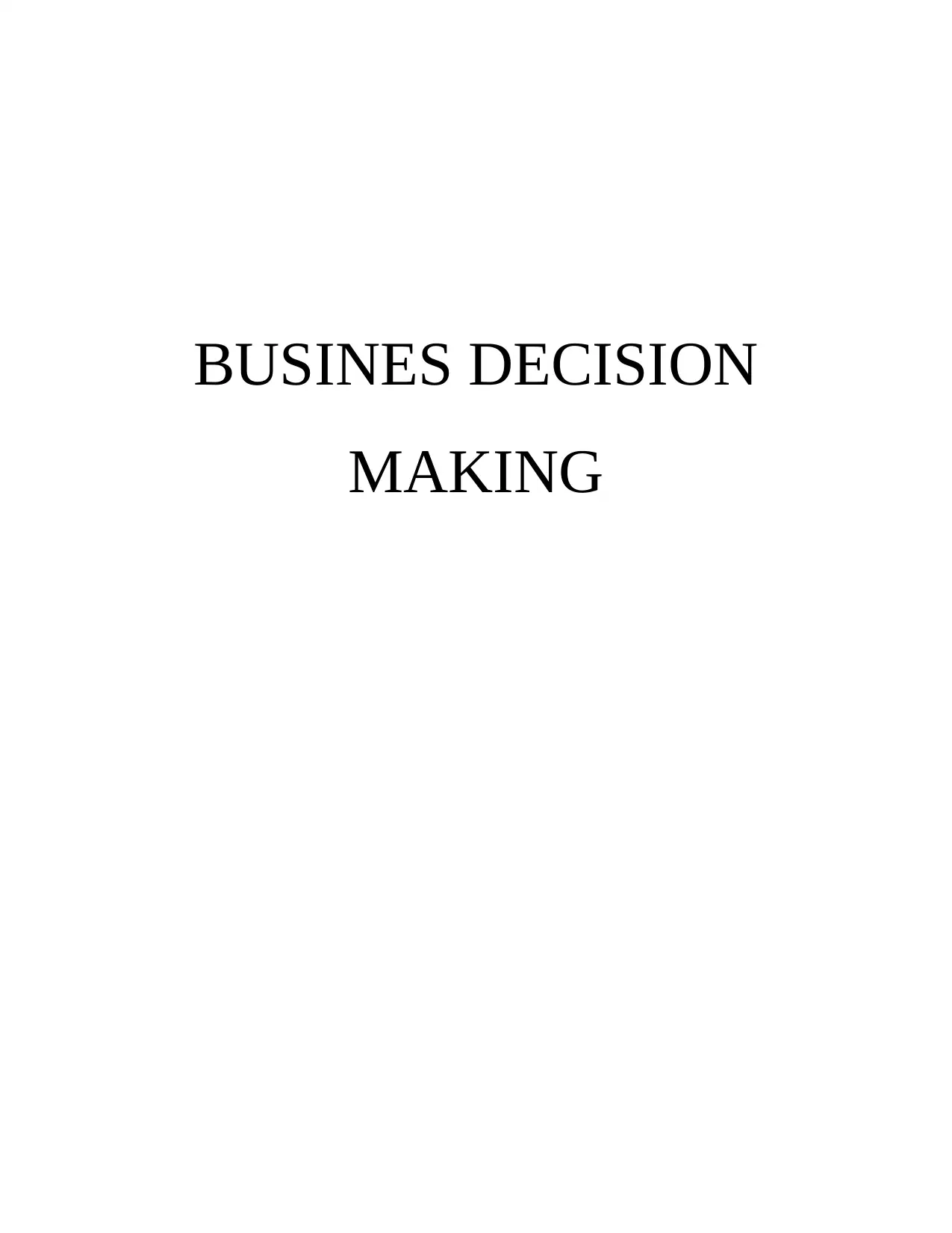
BUSINES DECISION
MAKING
MAKING
Paraphrase This Document
Need a fresh take? Get an instant paraphrase of this document with our AI Paraphraser
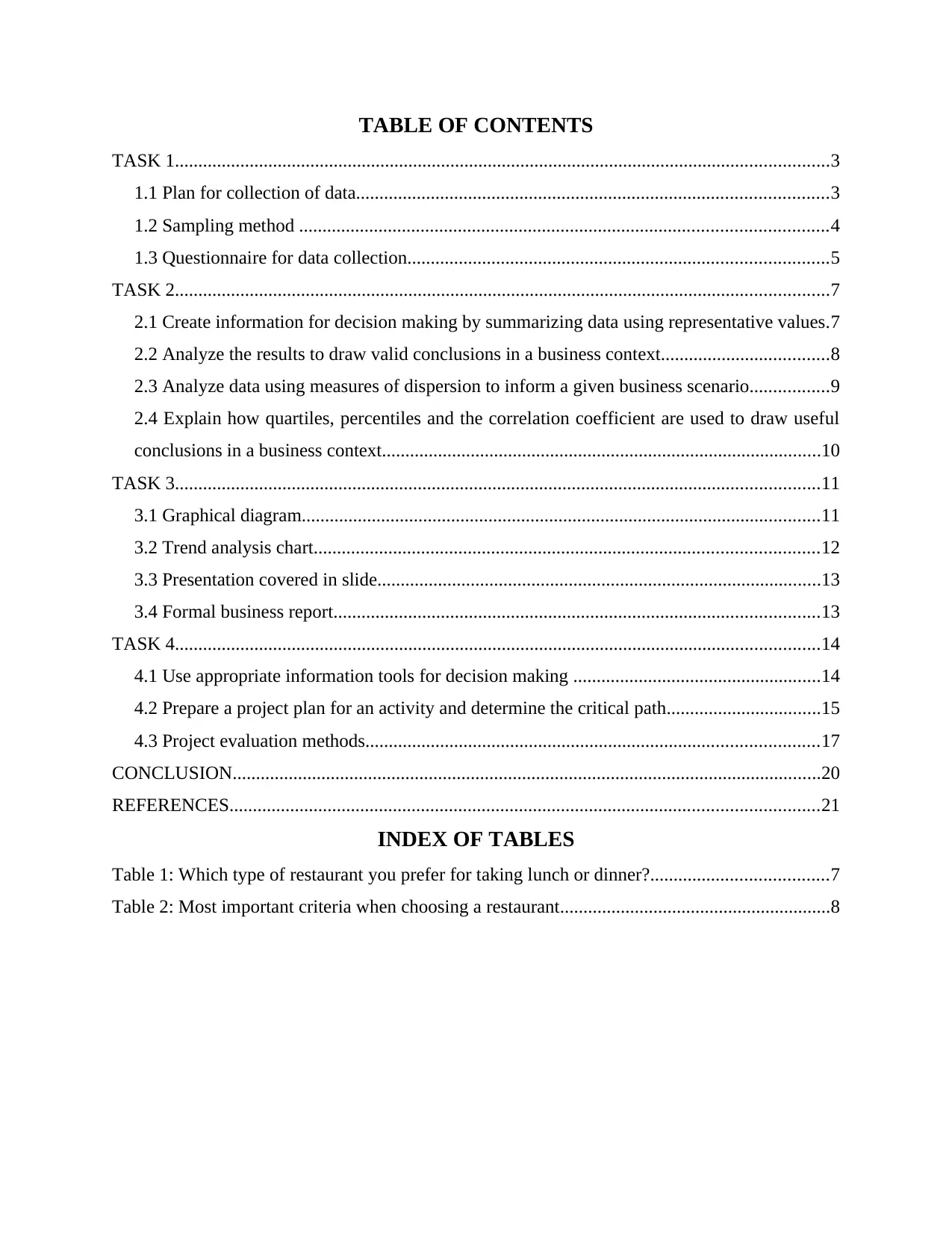
TABLE OF CONTENTS
TASK 1............................................................................................................................................3
1.1 Plan for collection of data.....................................................................................................3
1.2 Sampling method .................................................................................................................4
1.3 Questionnaire for data collection..........................................................................................5
TASK 2............................................................................................................................................7
2.1 Create information for decision making by summarizing data using representative values.7
2.2 Analyze the results to draw valid conclusions in a business context....................................8
2.3 Analyze data using measures of dispersion to inform a given business scenario.................9
2.4 Explain how quartiles, percentiles and the correlation coefficient are used to draw useful
conclusions in a business context..............................................................................................10
TASK 3..........................................................................................................................................11
3.1 Graphical diagram...............................................................................................................11
3.2 Trend analysis chart............................................................................................................12
3.3 Presentation covered in slide...............................................................................................13
3.4 Formal business report........................................................................................................13
TASK 4..........................................................................................................................................14
4.1 Use appropriate information tools for decision making .....................................................14
4.2 Prepare a project plan for an activity and determine the critical path.................................15
4.3 Project evaluation methods.................................................................................................17
CONCLUSION..............................................................................................................................20
REFERENCES..............................................................................................................................21
INDEX OF TABLES
Table 1: Which type of restaurant you prefer for taking lunch or dinner?......................................7
Table 2: Most important criteria when choosing a restaurant..........................................................8
TASK 1............................................................................................................................................3
1.1 Plan for collection of data.....................................................................................................3
1.2 Sampling method .................................................................................................................4
1.3 Questionnaire for data collection..........................................................................................5
TASK 2............................................................................................................................................7
2.1 Create information for decision making by summarizing data using representative values.7
2.2 Analyze the results to draw valid conclusions in a business context....................................8
2.3 Analyze data using measures of dispersion to inform a given business scenario.................9
2.4 Explain how quartiles, percentiles and the correlation coefficient are used to draw useful
conclusions in a business context..............................................................................................10
TASK 3..........................................................................................................................................11
3.1 Graphical diagram...............................................................................................................11
3.2 Trend analysis chart............................................................................................................12
3.3 Presentation covered in slide...............................................................................................13
3.4 Formal business report........................................................................................................13
TASK 4..........................................................................................................................................14
4.1 Use appropriate information tools for decision making .....................................................14
4.2 Prepare a project plan for an activity and determine the critical path.................................15
4.3 Project evaluation methods.................................................................................................17
CONCLUSION..............................................................................................................................20
REFERENCES..............................................................................................................................21
INDEX OF TABLES
Table 1: Which type of restaurant you prefer for taking lunch or dinner?......................................7
Table 2: Most important criteria when choosing a restaurant..........................................................8
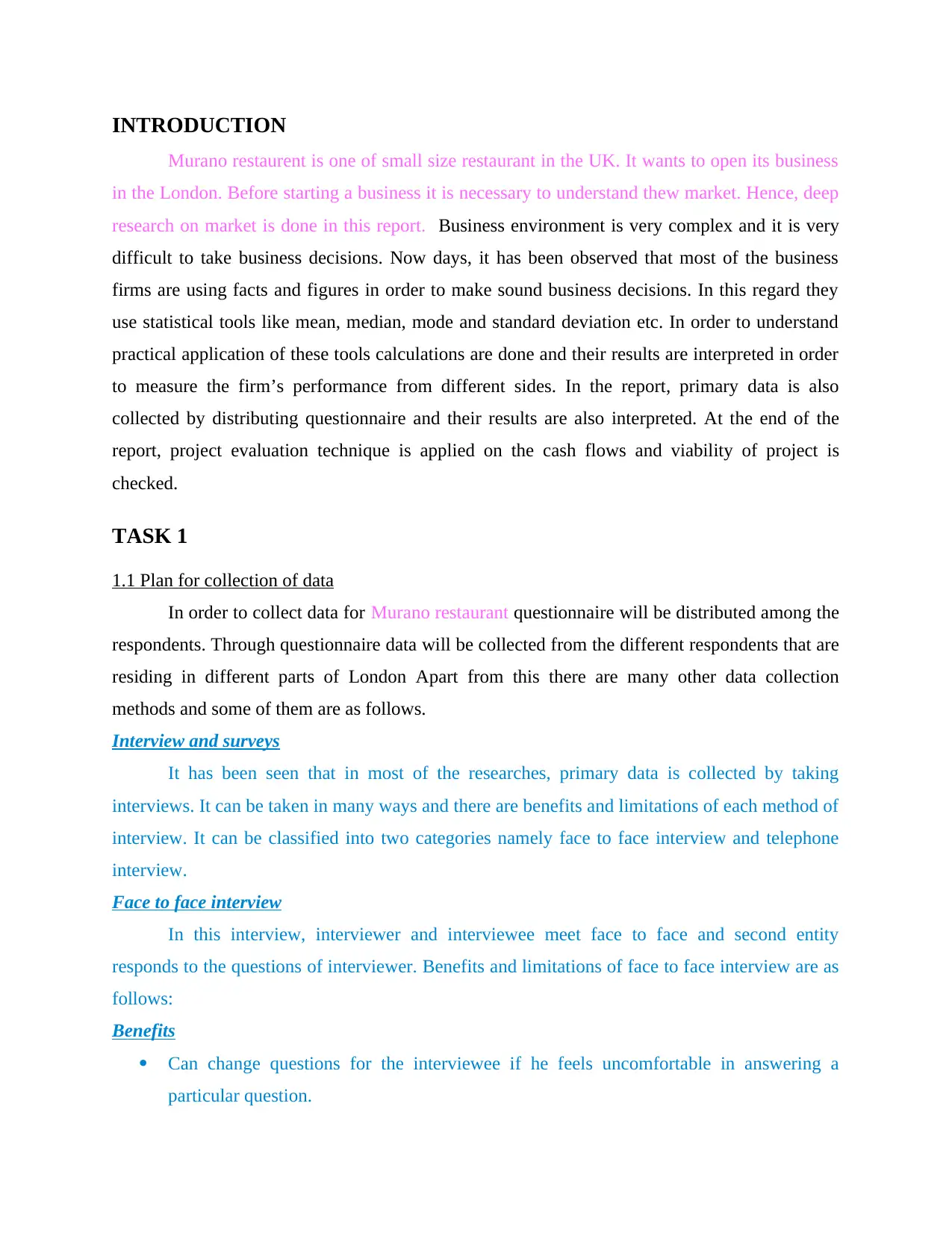
INTRODUCTION
Murano restaurent is one of small size restaurant in the UK. It wants to open its business
in the London. Before starting a business it is necessary to understand thew market. Hence, deep
research on market is done in this report. Business environment is very complex and it is very
difficult to take business decisions. Now days, it has been observed that most of the business
firms are using facts and figures in order to make sound business decisions. In this regard they
use statistical tools like mean, median, mode and standard deviation etc. In order to understand
practical application of these tools calculations are done and their results are interpreted in order
to measure the firm’s performance from different sides. In the report, primary data is also
collected by distributing questionnaire and their results are also interpreted. At the end of the
report, project evaluation technique is applied on the cash flows and viability of project is
checked.
TASK 1
1.1 Plan for collection of data
In order to collect data for Murano restaurant questionnaire will be distributed among the
respondents. Through questionnaire data will be collected from the different respondents that are
residing in different parts of London Apart from this there are many other data collection
methods and some of them are as follows.
Interview and surveys
It has been seen that in most of the researches, primary data is collected by taking
interviews. It can be taken in many ways and there are benefits and limitations of each method of
interview. It can be classified into two categories namely face to face interview and telephone
interview.
Face to face interview
In this interview, interviewer and interviewee meet face to face and second entity
responds to the questions of interviewer. Benefits and limitations of face to face interview are as
follows:
Benefits
Can change questions for the interviewee if he feels uncomfortable in answering a
particular question.
Murano restaurent is one of small size restaurant in the UK. It wants to open its business
in the London. Before starting a business it is necessary to understand thew market. Hence, deep
research on market is done in this report. Business environment is very complex and it is very
difficult to take business decisions. Now days, it has been observed that most of the business
firms are using facts and figures in order to make sound business decisions. In this regard they
use statistical tools like mean, median, mode and standard deviation etc. In order to understand
practical application of these tools calculations are done and their results are interpreted in order
to measure the firm’s performance from different sides. In the report, primary data is also
collected by distributing questionnaire and their results are also interpreted. At the end of the
report, project evaluation technique is applied on the cash flows and viability of project is
checked.
TASK 1
1.1 Plan for collection of data
In order to collect data for Murano restaurant questionnaire will be distributed among the
respondents. Through questionnaire data will be collected from the different respondents that are
residing in different parts of London Apart from this there are many other data collection
methods and some of them are as follows.
Interview and surveys
It has been seen that in most of the researches, primary data is collected by taking
interviews. It can be taken in many ways and there are benefits and limitations of each method of
interview. It can be classified into two categories namely face to face interview and telephone
interview.
Face to face interview
In this interview, interviewer and interviewee meet face to face and second entity
responds to the questions of interviewer. Benefits and limitations of face to face interview are as
follows:
Benefits
Can change questions for the interviewee if he feels uncomfortable in answering a
particular question.
⊘ This is a preview!⊘
Do you want full access?
Subscribe today to unlock all pages.

Trusted by 1+ million students worldwide
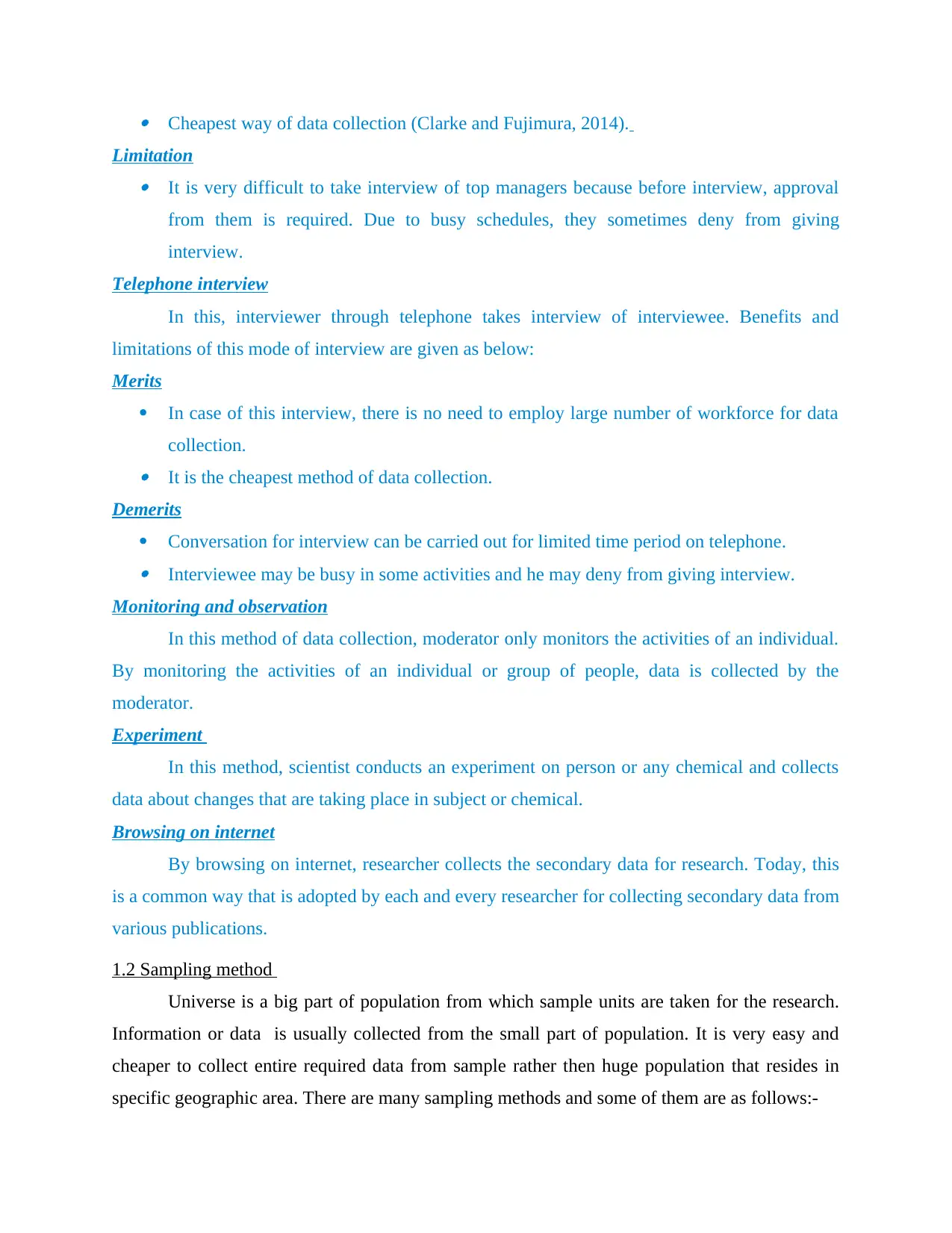
Cheapest way of data collection (Clarke and Fujimura, 2014).
Limitation It is very difficult to take interview of top managers because before interview, approval
from them is required. Due to busy schedules, they sometimes deny from giving
interview.
Telephone interview
In this, interviewer through telephone takes interview of interviewee. Benefits and
limitations of this mode of interview are given as below:
Merits
In case of this interview, there is no need to employ large number of workforce for data
collection. It is the cheapest method of data collection.
Demerits
Conversation for interview can be carried out for limited time period on telephone. Interviewee may be busy in some activities and he may deny from giving interview.
Monitoring and observation
In this method of data collection, moderator only monitors the activities of an individual.
By monitoring the activities of an individual or group of people, data is collected by the
moderator.
Experiment
In this method, scientist conducts an experiment on person or any chemical and collects
data about changes that are taking place in subject or chemical.
Browsing on internet
By browsing on internet, researcher collects the secondary data for research. Today, this
is a common way that is adopted by each and every researcher for collecting secondary data from
various publications.
1.2 Sampling method
Universe is a big part of population from which sample units are taken for the research.
Information or data is usually collected from the small part of population. It is very easy and
cheaper to collect entire required data from sample rather then huge population that resides in
specific geographic area. There are many sampling methods and some of them are as follows:-
Limitation It is very difficult to take interview of top managers because before interview, approval
from them is required. Due to busy schedules, they sometimes deny from giving
interview.
Telephone interview
In this, interviewer through telephone takes interview of interviewee. Benefits and
limitations of this mode of interview are given as below:
Merits
In case of this interview, there is no need to employ large number of workforce for data
collection. It is the cheapest method of data collection.
Demerits
Conversation for interview can be carried out for limited time period on telephone. Interviewee may be busy in some activities and he may deny from giving interview.
Monitoring and observation
In this method of data collection, moderator only monitors the activities of an individual.
By monitoring the activities of an individual or group of people, data is collected by the
moderator.
Experiment
In this method, scientist conducts an experiment on person or any chemical and collects
data about changes that are taking place in subject or chemical.
Browsing on internet
By browsing on internet, researcher collects the secondary data for research. Today, this
is a common way that is adopted by each and every researcher for collecting secondary data from
various publications.
1.2 Sampling method
Universe is a big part of population from which sample units are taken for the research.
Information or data is usually collected from the small part of population. It is very easy and
cheaper to collect entire required data from sample rather then huge population that resides in
specific geographic area. There are many sampling methods and some of them are as follows:-
Paraphrase This Document
Need a fresh take? Get an instant paraphrase of this document with our AI Paraphraser
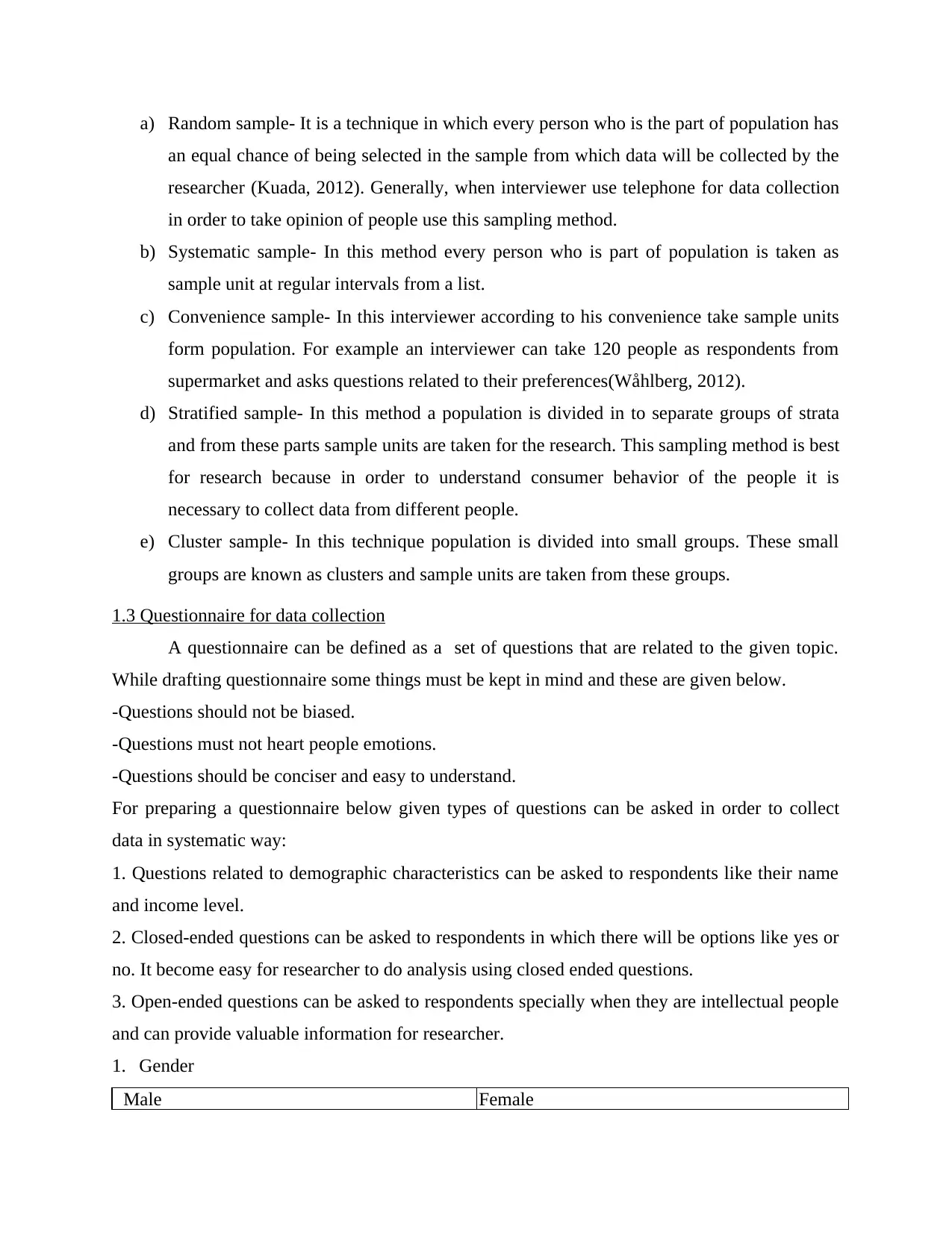
a) Random sample- It is a technique in which every person who is the part of population has
an equal chance of being selected in the sample from which data will be collected by the
researcher (Kuada, 2012). Generally, when interviewer use telephone for data collection
in order to take opinion of people use this sampling method.
b) Systematic sample- In this method every person who is part of population is taken as
sample unit at regular intervals from a list.
c) Convenience sample- In this interviewer according to his convenience take sample units
form population. For example an interviewer can take 120 people as respondents from
supermarket and asks questions related to their preferences(Wåhlberg, 2012).
d) Stratified sample- In this method a population is divided in to separate groups of strata
and from these parts sample units are taken for the research. This sampling method is best
for research because in order to understand consumer behavior of the people it is
necessary to collect data from different people.
e) Cluster sample- In this technique population is divided into small groups. These small
groups are known as clusters and sample units are taken from these groups.
1.3 Questionnaire for data collection
A questionnaire can be defined as a set of questions that are related to the given topic.
While drafting questionnaire some things must be kept in mind and these are given below.
-Questions should not be biased.
-Questions must not heart people emotions.
-Questions should be conciser and easy to understand.
For preparing a questionnaire below given types of questions can be asked in order to collect
data in systematic way:
1. Questions related to demographic characteristics can be asked to respondents like their name
and income level.
2. Closed-ended questions can be asked to respondents in which there will be options like yes or
no. It become easy for researcher to do analysis using closed ended questions.
3. Open-ended questions can be asked to respondents specially when they are intellectual people
and can provide valuable information for researcher.
1.” Gender”
Male Female
an equal chance of being selected in the sample from which data will be collected by the
researcher (Kuada, 2012). Generally, when interviewer use telephone for data collection
in order to take opinion of people use this sampling method.
b) Systematic sample- In this method every person who is part of population is taken as
sample unit at regular intervals from a list.
c) Convenience sample- In this interviewer according to his convenience take sample units
form population. For example an interviewer can take 120 people as respondents from
supermarket and asks questions related to their preferences(Wåhlberg, 2012).
d) Stratified sample- In this method a population is divided in to separate groups of strata
and from these parts sample units are taken for the research. This sampling method is best
for research because in order to understand consumer behavior of the people it is
necessary to collect data from different people.
e) Cluster sample- In this technique population is divided into small groups. These small
groups are known as clusters and sample units are taken from these groups.
1.3 Questionnaire for data collection
A questionnaire can be defined as a set of questions that are related to the given topic.
While drafting questionnaire some things must be kept in mind and these are given below.
-Questions should not be biased.
-Questions must not heart people emotions.
-Questions should be conciser and easy to understand.
For preparing a questionnaire below given types of questions can be asked in order to collect
data in systematic way:
1. Questions related to demographic characteristics can be asked to respondents like their name
and income level.
2. Closed-ended questions can be asked to respondents in which there will be options like yes or
no. It become easy for researcher to do analysis using closed ended questions.
3. Open-ended questions can be asked to respondents specially when they are intellectual people
and can provide valuable information for researcher.
1.” Gender”
Male Female
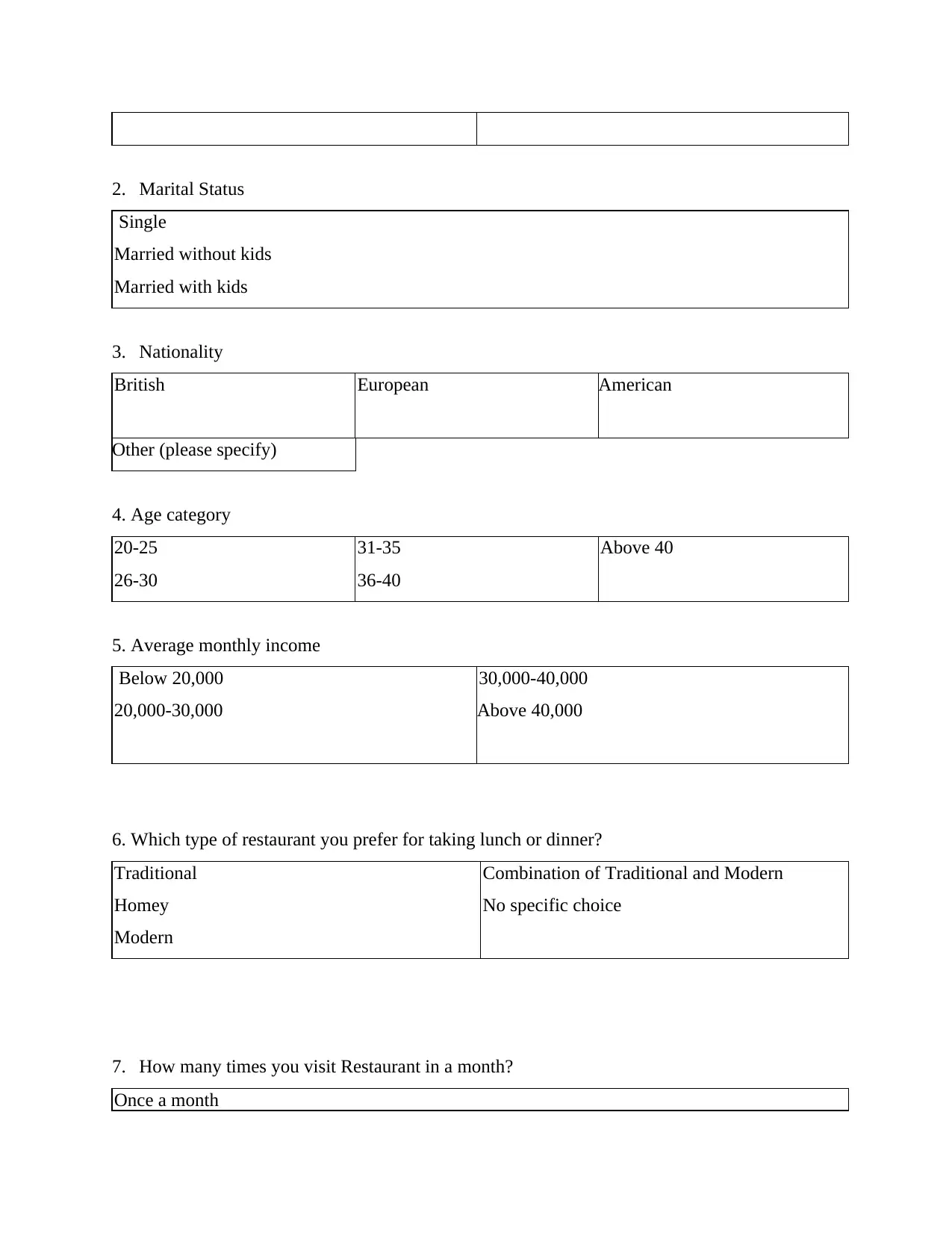
2. “Marital Status”
Single
Married without kids
Married with kids
3. “Nationality”
British European American
Other (please specify)
4. Age category
20-25
26-30
31-35
36-40
Above 40
5. Average monthly income
Below 20,000
20,000-30,000
30,000-40,000
Above 40,000
6. Which type of restaurant you prefer for taking lunch or dinner?
Traditional
Homey
Modern
Combination of Traditional and Modern
No specific choice
7.” How many times you visit Restaurant in a month?”
Once a month
Single
Married without kids
Married with kids
3. “Nationality”
British European American
Other (please specify)
4. Age category
20-25
26-30
31-35
36-40
Above 40
5. Average monthly income
Below 20,000
20,000-30,000
30,000-40,000
Above 40,000
6. Which type of restaurant you prefer for taking lunch or dinner?
Traditional
Homey
Modern
Combination of Traditional and Modern
No specific choice
7.” How many times you visit Restaurant in a month?”
Once a month
⊘ This is a preview!⊘
Do you want full access?
Subscribe today to unlock all pages.

Trusted by 1+ million students worldwide
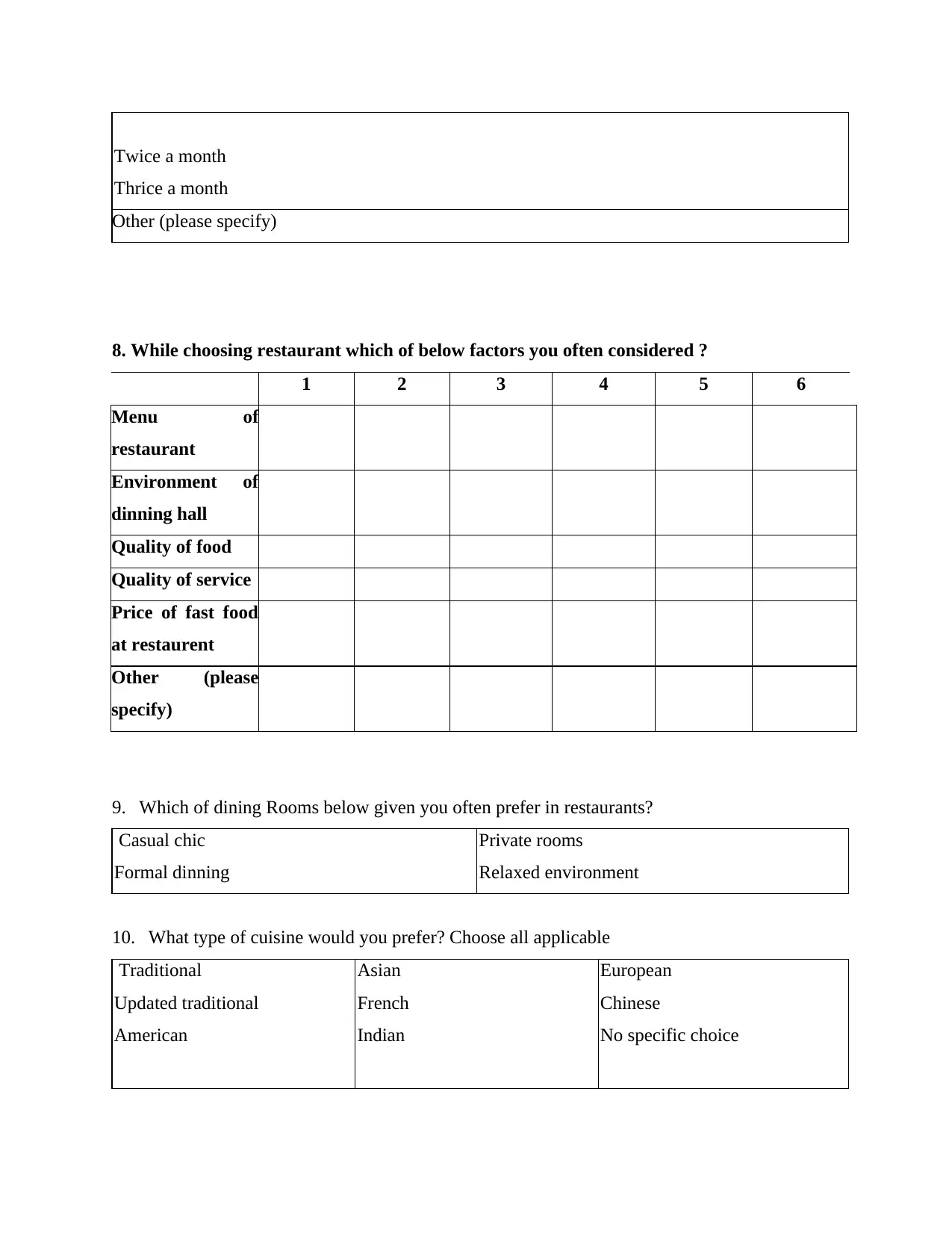
Twice a month
Thrice a month
Other (please specify)
8. While choosing restaurant which of below factors you often considered ?
1 2 3 4 5 6
Menu of
restaurant
Environment of
dinning hall
Quality of food
Quality of service
Price of fast food
at restaurent
Other (please
specify)
9. “Which of dining Rooms below given you often prefer in restaurants?”
Casual chic
Formal dinning
Private rooms
Relaxed environment
10. “What type of cuisine would you prefer? Choose all applicable”
Traditional
Updated traditional
American
Asian
French
Indian
European
Chinese
No specific choice
Thrice a month
Other (please specify)
8. While choosing restaurant which of below factors you often considered ?
1 2 3 4 5 6
Menu of
restaurant
Environment of
dinning hall
Quality of food
Quality of service
Price of fast food
at restaurent
Other (please
specify)
9. “Which of dining Rooms below given you often prefer in restaurants?”
Casual chic
Formal dinning
Private rooms
Relaxed environment
10. “What type of cuisine would you prefer? Choose all applicable”
Traditional
Updated traditional
American
Asian
French
Indian
European
Chinese
No specific choice
Paraphrase This Document
Need a fresh take? Get an instant paraphrase of this document with our AI Paraphraser
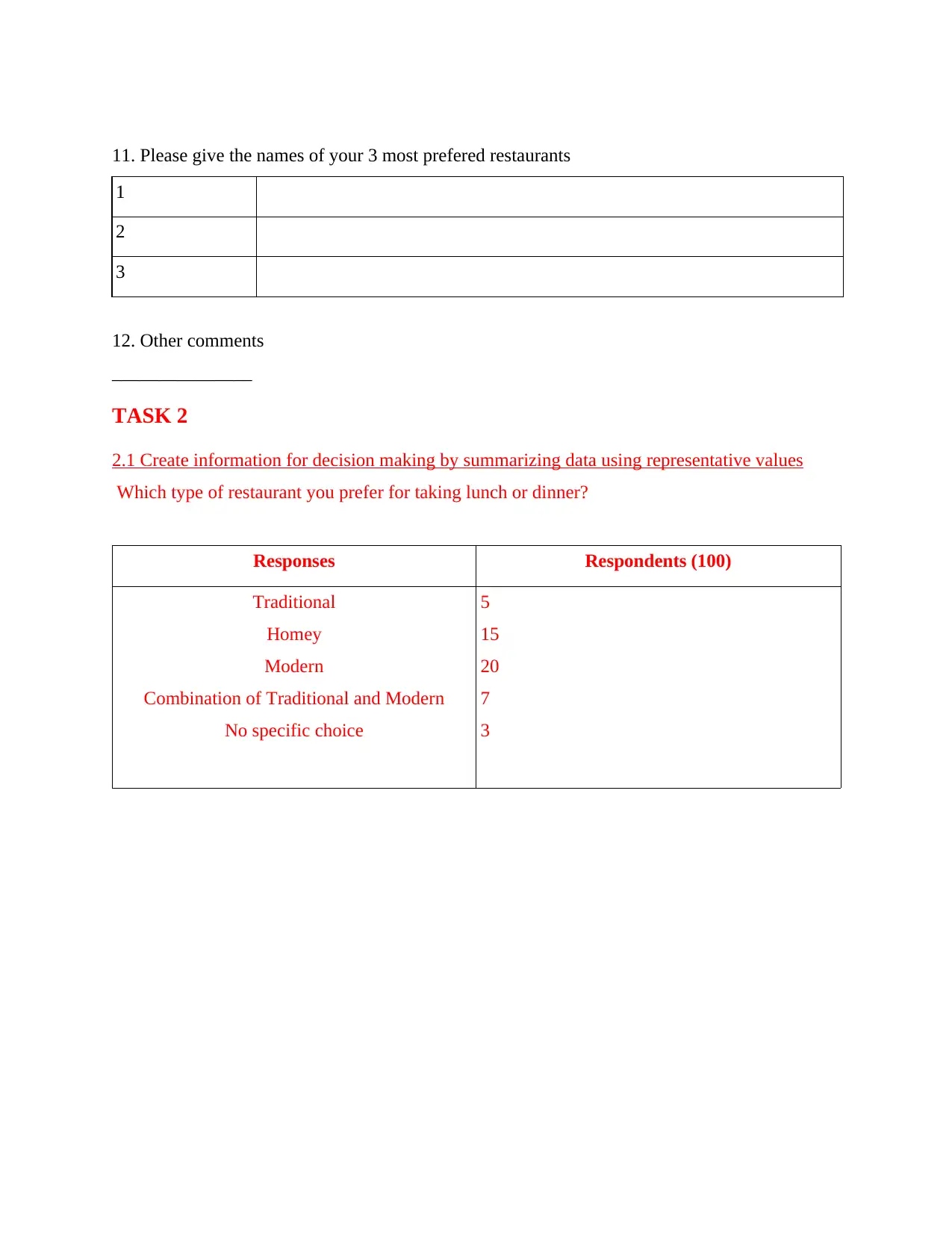
11. Please give the names of your 3 most prefered restaurants
1
2
3
12. Other comments
_______________
TASK 2
2.1 Create information for decision making by summarizing data using representative values
Which type of restaurant you prefer for taking lunch or dinner?
Responses Respondents (100)
Traditional
Homey
Modern
Combination of Traditional and Modern
No specific choice
5
15
20
7
3
1
2
3
12. Other comments
_______________
TASK 2
2.1 Create information for decision making by summarizing data using representative values
Which type of restaurant you prefer for taking lunch or dinner?
Responses Respondents (100)
Traditional
Homey
Modern
Combination of Traditional and Modern
No specific choice
5
15
20
7
3
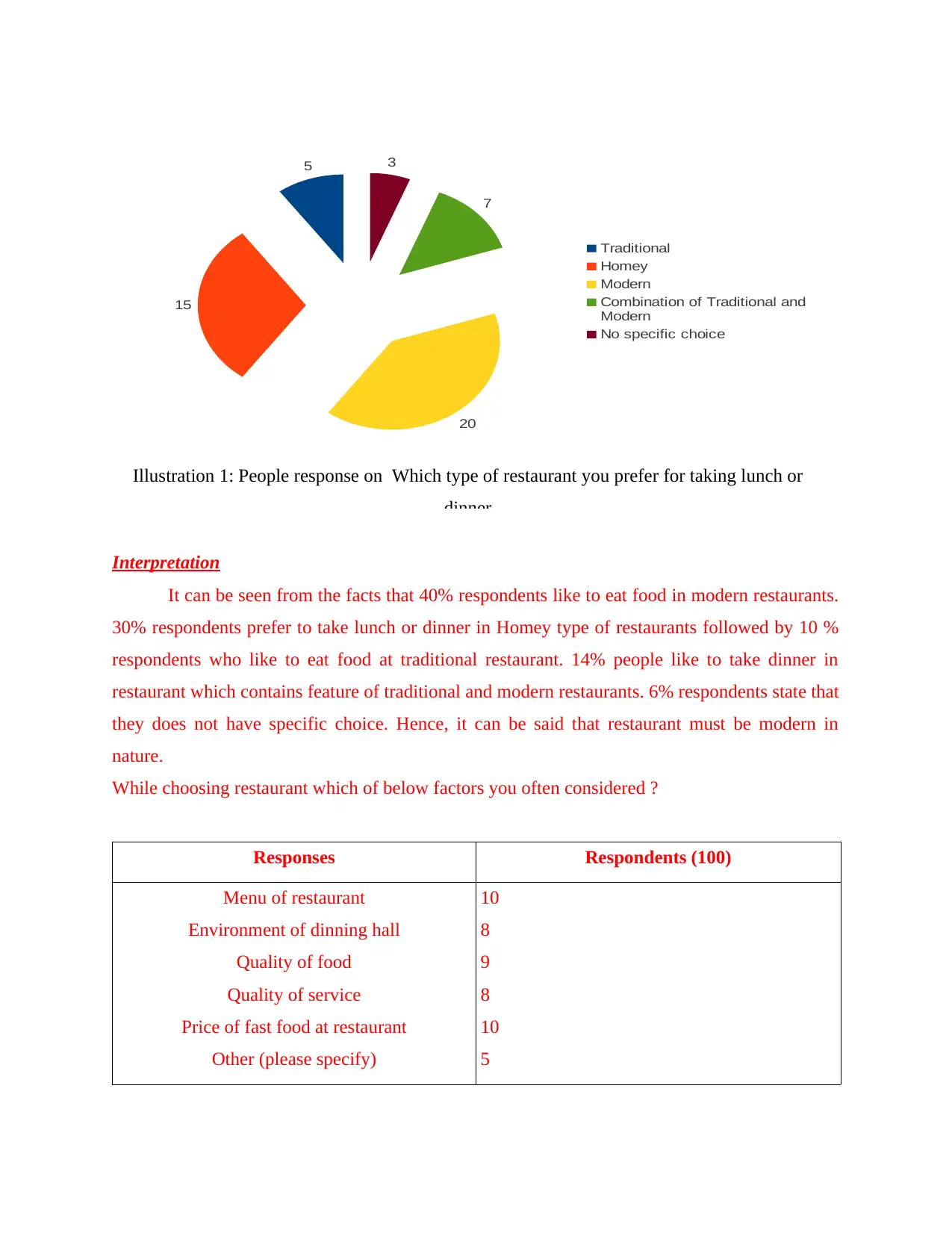
Interpretation
It can be seen from the facts that 40% respondents like to eat food in modern restaurants.
30% respondents prefer to take lunch or dinner in Homey type of restaurants followed by 10 %
respondents who like to eat food at traditional restaurant. 14% people like to take dinner in
restaurant which contains feature of traditional and modern restaurants. 6% respondents state that
they does not have specific choice. Hence, it can be said that restaurant must be modern in
nature.
While choosing restaurant which of below factors you often considered ?
Responses Respondents (100)
Menu of restaurant
Environment of dinning hall
Quality of food
Quality of service
Price of fast food at restaurant
Other (please specify)
10
8
9
8
10
5
5
15
20
7
3
Traditional
Homey
Modern
Combination of Traditional and
Modern
No specific choice
Illustration 1: People response on Which type of restaurant you prefer for taking lunch or
dinner
It can be seen from the facts that 40% respondents like to eat food in modern restaurants.
30% respondents prefer to take lunch or dinner in Homey type of restaurants followed by 10 %
respondents who like to eat food at traditional restaurant. 14% people like to take dinner in
restaurant which contains feature of traditional and modern restaurants. 6% respondents state that
they does not have specific choice. Hence, it can be said that restaurant must be modern in
nature.
While choosing restaurant which of below factors you often considered ?
Responses Respondents (100)
Menu of restaurant
Environment of dinning hall
Quality of food
Quality of service
Price of fast food at restaurant
Other (please specify)
10
8
9
8
10
5
5
15
20
7
3
Traditional
Homey
Modern
Combination of Traditional and
Modern
No specific choice
Illustration 1: People response on Which type of restaurant you prefer for taking lunch or
dinner
⊘ This is a preview!⊘
Do you want full access?
Subscribe today to unlock all pages.

Trusted by 1+ million students worldwide
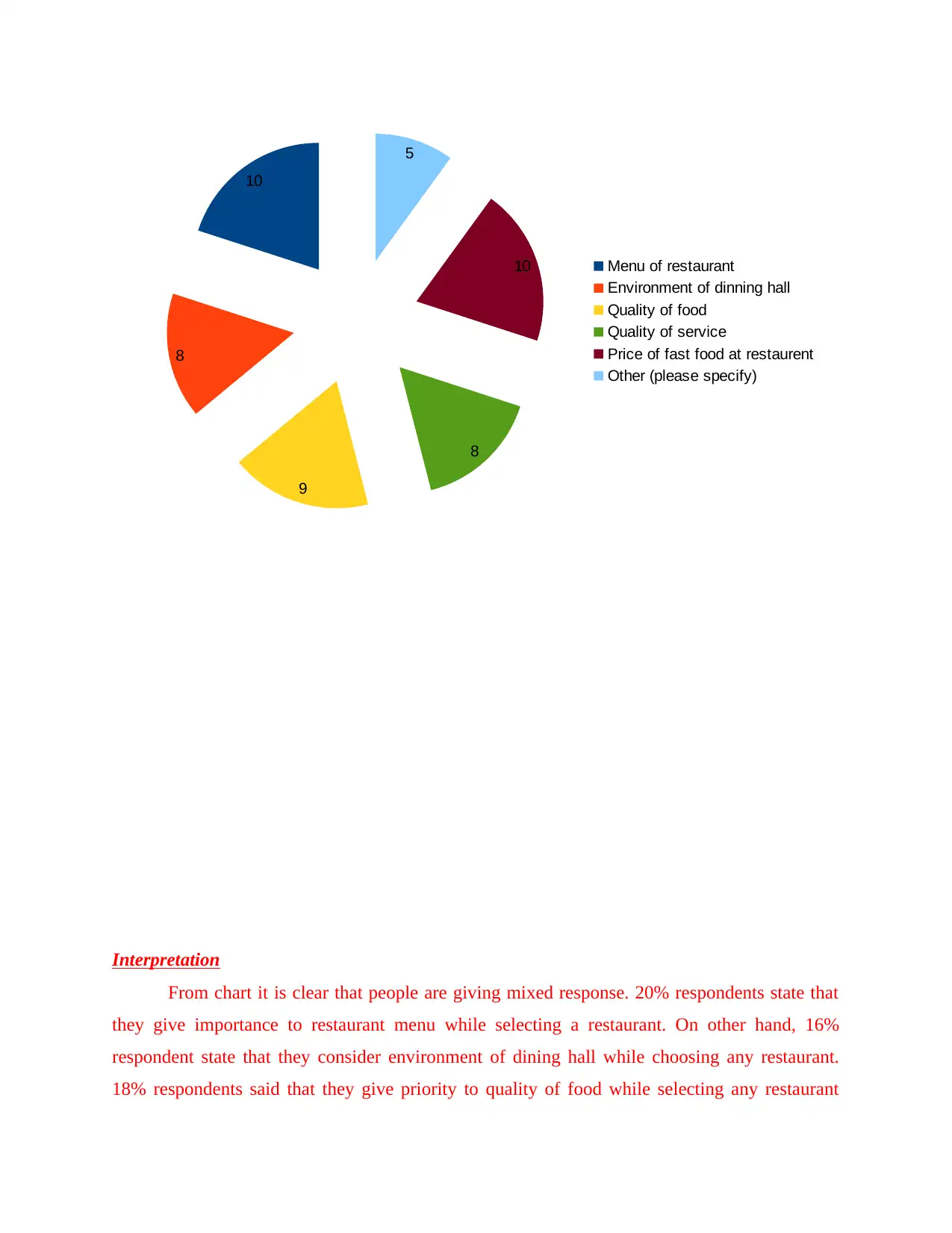
Interpretation
From chart it is clear that people are giving mixed response. 20% respondents state that
they give importance to restaurant menu while selecting a restaurant. On other hand, 16%
respondent state that they consider environment of dining hall while choosing any restaurant.
18% respondents said that they give priority to quality of food while selecting any restaurant
10
8
9
8
10
5
Menu of restaurant
Environment of dinning hall
Quality of food
Quality of service
Price of fast food at restaurent
Other (please specify)
From chart it is clear that people are giving mixed response. 20% respondents state that
they give importance to restaurant menu while selecting a restaurant. On other hand, 16%
respondent state that they consider environment of dining hall while choosing any restaurant.
18% respondents said that they give priority to quality of food while selecting any restaurant
10
8
9
8
10
5
Menu of restaurant
Environment of dinning hall
Quality of food
Quality of service
Price of fast food at restaurent
Other (please specify)
Paraphrase This Document
Need a fresh take? Get an instant paraphrase of this document with our AI Paraphraser
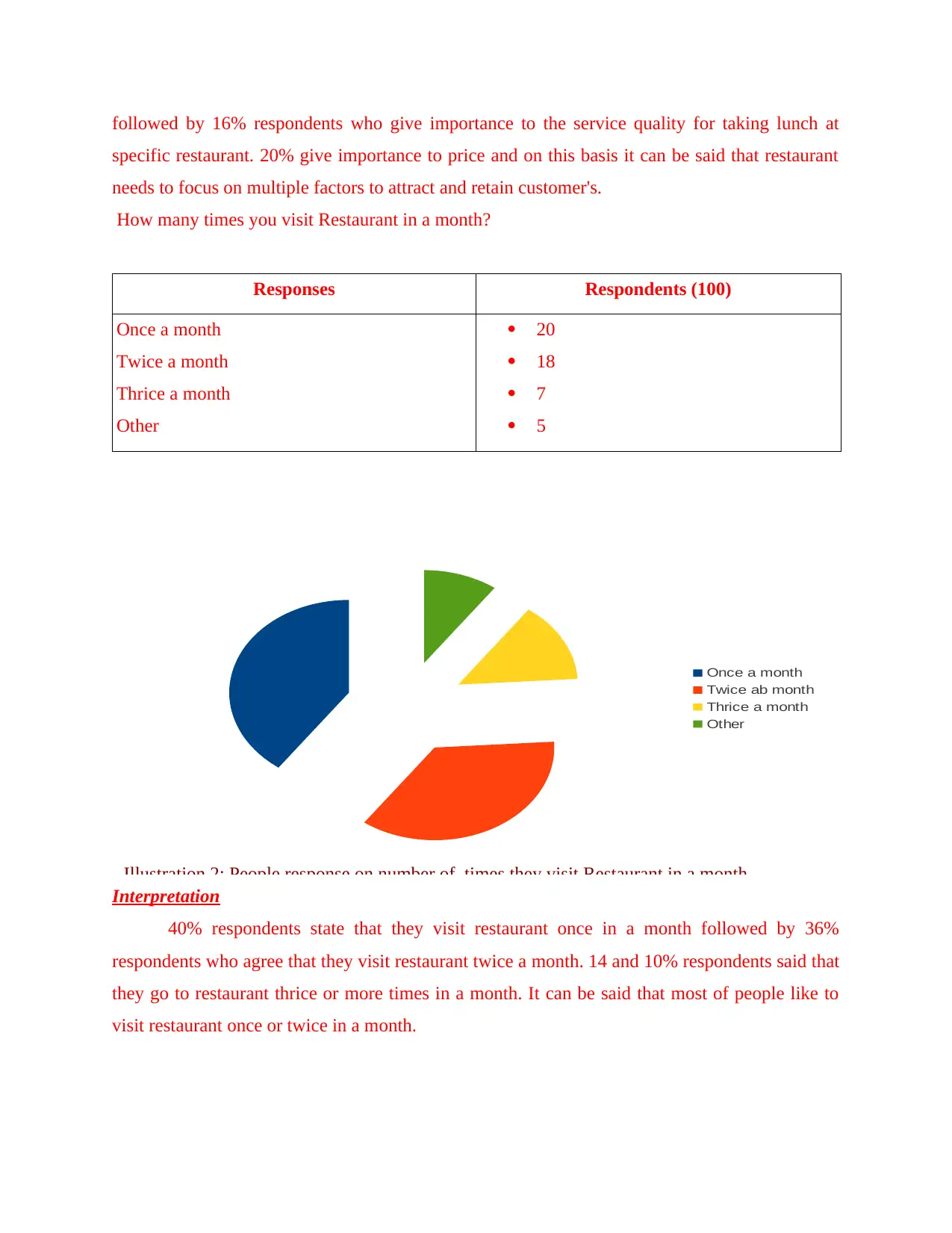
followed by 16% respondents who give importance to the service quality for taking lunch at
specific restaurant. 20% give importance to price and on this basis it can be said that restaurant
needs to focus on multiple factors to attract and retain customer's.
How many times you visit Restaurant in a month?
Responses Respondents (100)
Once a month
Twice a month
Thrice a month
Other
20
18
7
5
Interpretation
40% respondents state that they visit restaurant once in a month followed by 36%
respondents who agree that they visit restaurant twice a month. 14 and 10% respondents said that
they go to restaurant thrice or more times in a month. It can be said that most of people like to
visit restaurant once or twice in a month.
Once a month
Twice ab month
Thrice a month
Other
Illustration 2: People response on number of times they visit Restaurant in a month
specific restaurant. 20% give importance to price and on this basis it can be said that restaurant
needs to focus on multiple factors to attract and retain customer's.
How many times you visit Restaurant in a month?
Responses Respondents (100)
Once a month
Twice a month
Thrice a month
Other
20
18
7
5
Interpretation
40% respondents state that they visit restaurant once in a month followed by 36%
respondents who agree that they visit restaurant twice a month. 14 and 10% respondents said that
they go to restaurant thrice or more times in a month. It can be said that most of people like to
visit restaurant once or twice in a month.
Once a month
Twice ab month
Thrice a month
Other
Illustration 2: People response on number of times they visit Restaurant in a month
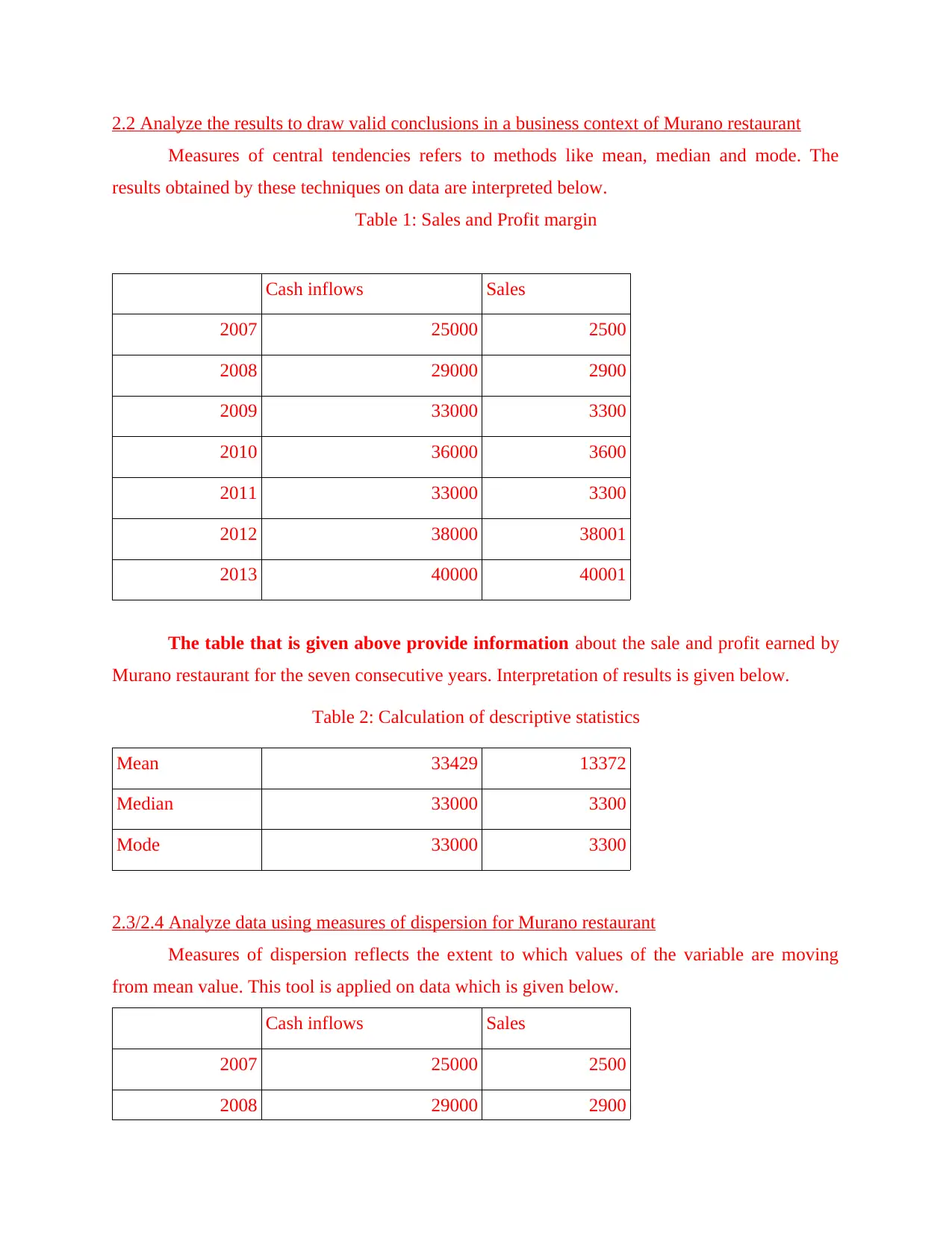
2.2 Analyze the results to draw valid conclusions in a business context of Murano restaurant
Measures of central tendencies refers to methods like mean, median and mode. The
results obtained by these techniques on data are interpreted below.
Table 1: Sales and Profit margin
Cash inflows Sales
2007 25000 2500
2008 29000 2900
2009 33000 3300
2010 36000 3600
2011 33000 3300
2012 38000 38001
2013 40000 40001
The table that is given above provide information about the sale and profit earned by
Murano restaurant for the seven consecutive years. Interpretation of results is given below.
Table 2: Calculation of descriptive statistics
Mean 33429 13372
Median 33000 3300
Mode 33000 3300
2.3/2.4 Analyze data using measures of dispersion for Murano restaurant
Measures of dispersion reflects the extent to which values of the variable are moving
from mean value. This tool is applied on data which is given below.
Cash inflows Sales
2007 25000 2500
2008 29000 2900
Measures of central tendencies refers to methods like mean, median and mode. The
results obtained by these techniques on data are interpreted below.
Table 1: Sales and Profit margin
Cash inflows Sales
2007 25000 2500
2008 29000 2900
2009 33000 3300
2010 36000 3600
2011 33000 3300
2012 38000 38001
2013 40000 40001
The table that is given above provide information about the sale and profit earned by
Murano restaurant for the seven consecutive years. Interpretation of results is given below.
Table 2: Calculation of descriptive statistics
Mean 33429 13372
Median 33000 3300
Mode 33000 3300
2.3/2.4 Analyze data using measures of dispersion for Murano restaurant
Measures of dispersion reflects the extent to which values of the variable are moving
from mean value. This tool is applied on data which is given below.
Cash inflows Sales
2007 25000 2500
2008 29000 2900
⊘ This is a preview!⊘
Do you want full access?
Subscribe today to unlock all pages.

Trusted by 1+ million students worldwide
1 out of 25
Related Documents
Your All-in-One AI-Powered Toolkit for Academic Success.
+13062052269
info@desklib.com
Available 24*7 on WhatsApp / Email
![[object Object]](/_next/static/media/star-bottom.7253800d.svg)
Unlock your academic potential
Copyright © 2020–2025 A2Z Services. All Rights Reserved. Developed and managed by ZUCOL.





